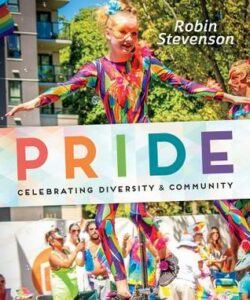Pride: The Celebration and the Struggle
Robin Stevenson
Orca Book Publishers
Published March 24, 2020
Amazon | Bookshop | Goodreads
About Pride: The Celebration and the Struggle
Like the original version, this new edition of Pride: The Celebration and the Struggle celebrates the LGBTQ+ community’s diversity and the incredible victories of the past 50 years–but it also has a larger focus on activism, the need to keep fighting for equality and freedom around the world and the important role that young people are playing.
The new edition has been updated and expanded to include many new Proud Moments and Queer Facts as well as a profile of LGBTQ+ refugees from Indonesia, a story about a Pride celebration in a refugee camp in Kenya and profiles of young activists, including teens from a Gender and Sexuality Alliance organizing Pride in Inuvik and a trans girl from Vancouver fighting for inclusion and support in schools. There is also a section on being an ally, a profile of a family with two gay dads (one of them trans) and much, much more!
Praise for the first edition, Pride: Celebrating Diversity & Community
“LGBTQ culture and rights are covered through the prism of Pride in this timely work…This attractive work will be welcomed by readers searching for guidance and hope.”–Kirkus Reviews
“Informative…Positively festive in its attitudes and outlook, this book more than lives up to the word celebrating in its subtitle.”–Booklist
“Upbeat and matter-of-fact…These stories, sad and happy, are where vulnerable preteen kids may see themselves.”–Quill & Quire
“An excellent and necessary addition for all collections.”–School Library Journal
My Review
I haven’t read any other books about the history of Pride, so I don’t have anything to compare this one to, but I really enjoyed reading the book. I love that it’s a book for kids, and I think it’s written in a really accessible, engaging way.
The opening of the book focuses on the history of Pride celebrations and protests, and I felt like it gave tribute to a lot of specific people who made big differences in the movement. The margins contain powerful and inspiring quotes. Sometimes a bar at the bottom of the page would show “Queer Facts” or important definitions.
One of the chapters that really sticks with me is the one about how Pride is celebrated around the world. Not only does the book teach about places where positive steps are being made for freedom and equality, but it also highlights places where Pride has been outlawed, or where identifying as LGBTQIA+ is dangerous or illegal.
I feel like I learned so much reading this book. It made me want to find the nearest Pride parade and join. It made me want to learn even more about the history of gay rights. Reading this book, I felt more connected to what’s happening right now not just in the US where I live but across the world. This is one of those books I want everyone to read. Not just those identifying as queer and allies, but everyone.
Content Notes
Recommended for Ages 12 up.
Representation
The book focuses on some members of the LGBTQIA+ community and their contributions to Pride protests and celebrations.
Profanity/Crude Language Content
None.
Romance/Sexual Content
No explicit sexual content.
Spiritual Content
Some pages talk about LGBTQIA+ people of different faiths, mainly Christians, Muslims, and Jews.
Violent Content
References to police brutality or violence against members of the LGBTQIA+ community.
Drug Content
None.
Note: This post contains affiliate links, which do not cost you anything to use, but which help support running this blog.
